 Body
piercing,
tattooing,
painting
in the galleries
of the
Body
piercing,
tattooing,
painting
in the galleries
of the
Penn Museum.
Examples
of Body Modification in the Collections of the Penn
Museum

|
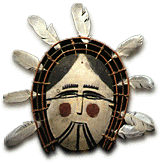
|
Blueberry
Woman
Athapaskan, 1917
NA 5822b
This wooden plaque mask was created to tell
the story of a woman who went to pick blueberries. Rather than
collecting the fruit, she danced with her basket pretending
to be industrious. The mask has many features similar to those
employed by Bering Sea Eskimos and of religious significance
to them. These include a down-turned mouth and chin tattoos,
symbols of females; a pair of goggles, an indication of a supernatural
quality; and hoops and feathers, references to celestial bodies.
The symmetry of the mask is typical of Athapaskan workmanship,
as are the woman's red cheek spots.
go to...
|
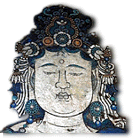
|
Detail
from "Bhaisajyaguru and Assembly"
China, Shanxi Province, Ziaocheng, Guangsheng Monstery (Monastery
of Vast Triumph)
After 1475, Ming Dynasty (A.D. 1368-1644)
C688
This detail is from a wall mural made of tempera on mud, mixed
with seed, straw, and leaves.
go to...China
|
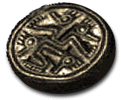 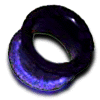
|
Ear
Plug and Spool
Guatemala, Post-Classic Period (A.D. 900-1500)
Although found in the highlands of Guatemala,
these pieces of thinly worked obsidian may have been traded
from a Post-Classic Mexican center specializing in producing
such extraordinary ornaments.
go to...Mesoamerica
|

|
Female
Figure
Lulua, Zaire, 19th century
AF 628
Some of the most beautiful small-scale carvings
of West Africa are female figures like this one made by the
Lulua of Zaire. The elaborate designs on the surface of the
figure represent Lulua scarification patterns. They are used
to bring good fortune and beauty to their owners as well as
to ward off sickness and other evil forces. They are often placed
near the beds of newborn children to protect them. The scarification
markings were considered beautiful and were used to attract
benevolent spirits.
go to...Africa
|
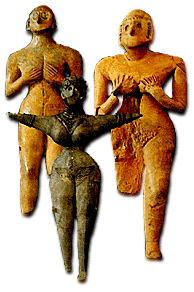
|
Female
Figurines
Tureng Tepe, Iran, IIIB Period, ca. 3500-2900 B.C.
32-41-25, 32-41-68, 32-41-69
Three standing nude female figurines with ears
pierced for multiple earrings.
go to...Near
East
|
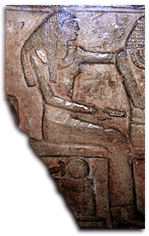
|
Funerary
Stela
Egypt, Dendera, ca. 2130-2000 B.C. , 9-11th Dynasties
29-66-645
Note the mirror and cosmetic box beneath the
chair.
go to...Egypt
|
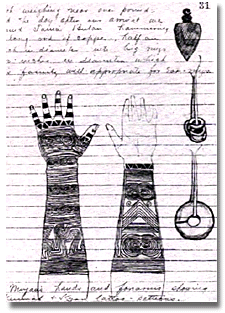
|
Tattoos
and Ear Ornaments
Borneo, 1896
A page from Hiram Hiller's Borneo journal (Pata
River, June 16, 1896). At right, sketches of heavy ear ornaments
worn by Kenyah women. At bottom, sketches of the tattoo patterns
on a Kenyah woman's hands and forearms. For more information,
see Expedition
Magazine, the Museum's magazine that
explores our human past and present, Volume 30, No. 1.
|

go to...Ancient
Greek World
|
Gold
Earrings
Cyprus, late 4th-2nd century B.C.
34-1-1
Each earring takes the form of a bull's head and neck. Jewelry
is frequently represented on vases and sculptures. Otherwise,
our knowledge comes from actual specimens recovered mostly from
tombs and sanctuaries.
|

|
Labret
Point Barrow, Alaska, 1897
42306
|
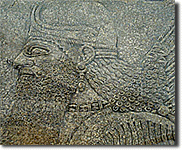
go to...Near
East
|
Detail
from a Relief
Palace of Assur-nasir-pal, Nimrud, Iraq, 9th century B.C.
29-21-1
This detail is from a relief of a winged genius carrying a lustration
pail and pine cone and is incised with a standard 20-line inscription
stating the power of King Assur and listing his conquests.
|
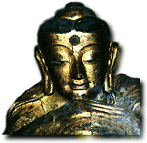
|
Sakyamuni
Buddha
China, Yuan Dynasty (A.D. 1279-1368)
C405A
go to...China
|
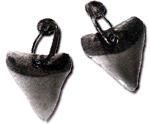
|
Shark
Tooth Earrings
Sitka, Collected by Louis Shotridge, 1918
NA 8482(RG3)
|
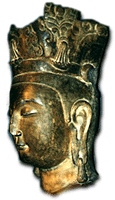
|
Stone Head of a Bodhisattva
China
Northern Qi Period (A.D. 550-577)
C444
Many Buddhist statues are depicted with stretched earlobes.
In Tibet, stretched earlobes are a sign of wisdom.
|

|
Tattooing
Comb
Samoa, 19th century
L-9-126
Samoan tattoo artists used combs like this one
to apply the design. They dipped the comb in a mixture of water
and candlenut soot and tapped the comb with a stick to make
the pointed teeth puncture the skin. This tattooing comb is
made of bone, turtle shell, wood, and vegetable fiber.
|
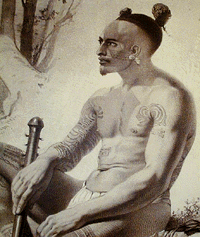
|
Tattooed
Chief
Taiohae, Nukuhiva, 19th century.
The Museum's Polynesia gallery contains several examples of
tattooing, including this drawing of a 19th century Marquesan
chief with tattoos on his face, torso, and limbs.
|
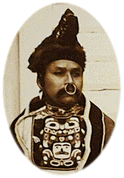
|
Tlingit
Man with Nose Ring
Sitka, Alaska, late 19th century
PCA57-33, detail of photograph by E. W. Merrill
|
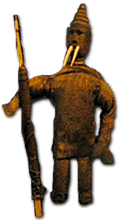
|
Walrus
Man
Point Barrow, Alaska
Collected by E.A. McIlhenny, 1897
41855
Alaskan Eskimos believed that in the mythological past all humans,
animals, and spirits could change their physical forms at will.
In the nineteenth century, only spirits and shamans retained
the ability to undergo transformations. The belief in transformation
explains the cautious way Alaskan Eskimos dealt with strangers
and animals that behaved in peculiar ways. Such beings might
have been dangerous supernatural characters or hostile shamans
in disguise.The theme of a walrus-man transformation was commonly
expressed in Eskimo material through the use of the double tusk
motif. The walrus-man represented in this carving wears a hunting
visor and holds a harpoon in his hand.
go to...
|

|
Woman
at Festival
Papua, New Guinea, August, 1982
detail of photo by Jordan M. Wright
In the highlands of New Guinea, people participate in a yearly
fair, an extravaganza of parading, dancing, singing, and the
display of costumes and body decoration. While most highland
New Guineans recognize personal decoration as an art form that
is used to mark important social events, there is no standardization
of symbolic meanings from one group to the next.
|
|
 Body
piercing,
tattooing,
painting
in the galleries
of the
Body
piercing,
tattooing,
painting
in the galleries
of the 